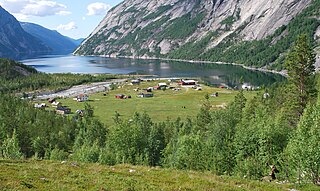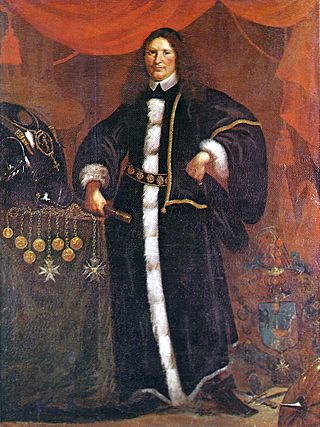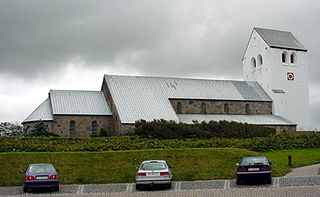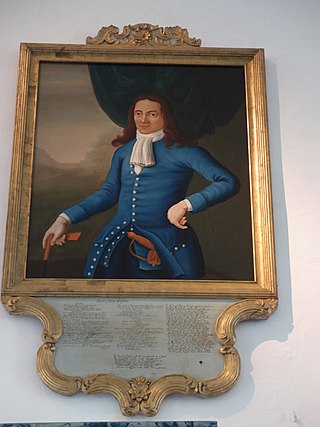
Bremen-Verden, formally the Duchies of Bremen and Verden, were two territories and immediate fiefs of the Holy Roman Empire, which emerged and gained imperial immediacy in 1180. By their original constitution they were prince-bishoprics of the Archdiocese of Bremen and Bishopric of Verden.

Northern Norway is a geographical region of Norway, consisting of the three northernmost counties Nordland, Troms and Finnmark, in total about 35% of the Norwegian mainland. Some of the largest towns in Northern Norway are Mo i Rana, Bodø, Narvik, Harstad, Tromsø and Alta. Northern Norway is often described as the land of the midnight sun and the land of the northern lights. Farther north, halfway to the North Pole, is the Arctic archipelago of Svalbard, traditionally not regarded as part of Northern Norway.

Cort Sivertsen Adeler, known in Denmark as Coort Sifvertsen Adelaer, in the Netherlands as Koert Sievertsen Adelaer and in Italy as Curzio Suffrido Adelborst, was the name of honour given to Kurt Sivertsen, a Norwegian seaman, who rendered distinguished service to the Danish and Dutch navies, and also to the Republic of Venice against the Turks.

Itzehoe is a town in Schleswig-Holstein in northern Germany.

Ulrik Frederik Gyldenløve, Landgrave of Laurvig was Governor-general of Norway from 1664–1699. He was the leading general in Norway during the Scanian War, whose Norwegian leg is conventionally named the Gyldenløve War after him. In Norway he was also the Landgrave of Laurvig.
The aristocracy of Norway is the modern and medieval aristocracy in Norway. Additionally, there have been economical, political, and military elites that—relating to the main lines of Norway's history—are generally accepted as nominal predecessors of the aforementioned. Since the 16th century, modern aristocracy is known as nobility.

Vestervig is a village in Vestervig Parish in Denmark, located in Thisted municipality in North Denmark Region. Vestervig has a population of 595. It has a disproportionately large church, Vestervig Abbey, which served as a cathedral until 1130 when the see was transferred to Børglum.

Joachim Irgens von Westervick, born as Jochum Jürgens, was a Dano-Norwegian nobleman, a Danish official and an estate owner. He was one of the most important financial magnates and entrepreneurs in Denmark–Norway and also hold land in the Netherlands. Between 1666 and 1675 he owned the Norwegian Irgens Estate, which was huge part of Northern Norway, as a private estate. He held the titles of Lord of Vestervig, Lord of Horsleben and Noordlanden. The Danish variant of his name by birth was Joachim Irgens.

Angell is a family in Norway. In the 1650s the family came as merchants to Trondheim, where they took their current name. From there parts of the family entered the proprietarian aristocracy in Central und Northern Norway. The part of the family which remained in Trondheim gained a prominent position still visible in the city today, especially through the Thomas Angell Foundations, one of the biggest landowners in Trøndelag and among other activities running the charity Thomas Angell House.
Tromsø Estate (Tromsøgodset) was an estate located in Troms, Norway. It was once part of the more sizable Irgens Estate.

Gjorslev is a cruciform medieval castle located 17 km south-east of Køge, on the Stevns Peninsula, Stevns Municipality, some forty kilometres south of Copenhagen, Denmark. Originally owned by the Bishop of Roskilde, it is considered one of the most well-preserved examples of Gothic secular architecture in Denmark.

The Irgens House, also known as the Old Artillery Barracks, is a heritage listed building complex situated on Strandgade in the Christianshavn district of central Copenhagen, Denmark. It takes its name after Joachim Irgens, one of its first owners. The property was later owned by the wealthy general trader Peter Borre. The karge building complex was later adapted for use as artillery barracks. It was kater joined by Wildersgade Barracks and Bpdsmandsgade Barracks on nearby sites. The army left the buildings in 1923. The complex has since been converted into apartments.

Farumgård is a former manor house overlooking Farum Lake at Farum, Furesø Municipality, in the north-western outskirts of Copenhagen, Denmark. It is located just east of Farum Church and the original Farum village. The land has been sold off and redeveloped, except for the 6 hectares park which is laid out in the Baroque style.
Events in the year 1666 in Norway.

Lorentz Lossius was a German-born Norwegian mining engineer. He was the founder and first director of the Røros Copper Works.
Irgens is a Norwegian surname. Notable people with the surname include:
Lorentz Mortensen Angell was a merchant and landowner in Norway.
Svenstrup is a manor house and estate located close to Borup, Køge Municipality, some 50 kilometres southwest of Copenhagen, Denmark. It has belonged to members of the Neergaard/Wedell-Neergaard family since 1751.

Gerard Bicker (I) van Swieten, Lord of Swieten was a Dutch aristocrat and civil servant.

Jacob, Count Palatine and Baron de Petersen was a Danish and brunswijker courtier, politician and diplomat. He wore the dignity of Count Palatine, imperial Baron, Lord of Engelenburg, Aschat and the house of Heiligenberg. At the end of the 17th century, De Petersen became the largest landowner in Northern Norway through inheritance.














